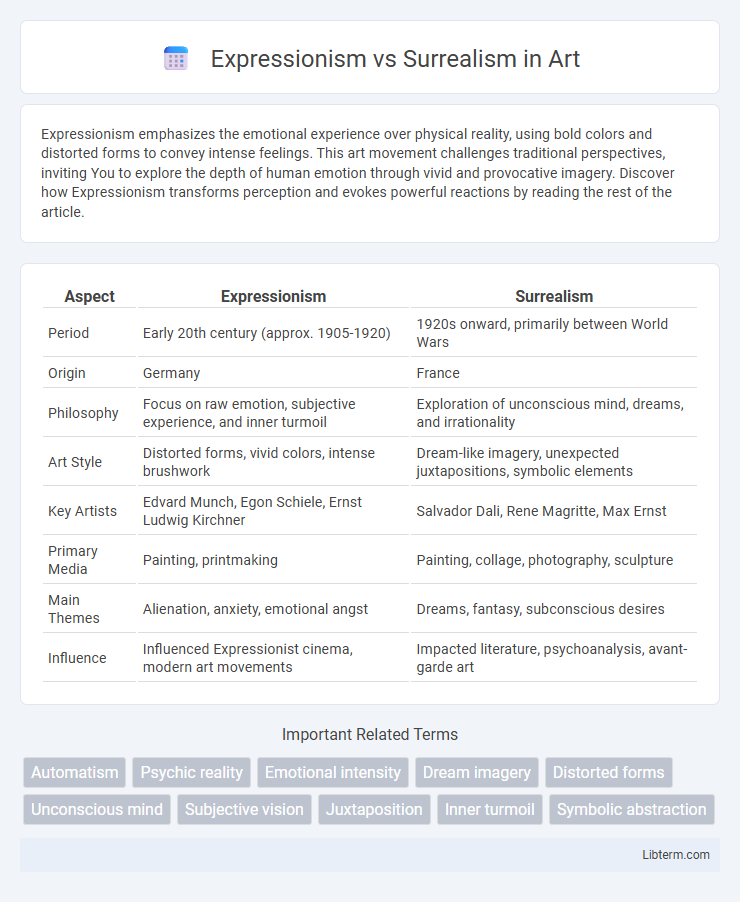Expressionism emphasizes the emotional experience over physical reality, using bold colors and distorted forms to convey intense feelings. This art movement challenges traditional perspectives, inviting You to explore the depth of human emotion through vivid and provocative imagery. Discover how Expressionism transforms perception and evokes powerful reactions by reading the rest of the article.
Table of Comparison
| Aspect | Expressionism | Surrealism |
|---|---|---|
| Period | Early 20th century (approx. 1905-1920) | 1920s onward, primarily between World Wars |
| Origin | Germany | France |
| Philosophy | Focus on raw emotion, subjective experience, and inner turmoil | Exploration of unconscious mind, dreams, and irrationality |
| Art Style | Distorted forms, vivid colors, intense brushwork | Dream-like imagery, unexpected juxtapositions, symbolic elements |
| Key Artists | Edvard Munch, Egon Schiele, Ernst Ludwig Kirchner | Salvador Dali, Rene Magritte, Max Ernst |
| Primary Media | Painting, printmaking | Painting, collage, photography, sculpture |
| Main Themes | Alienation, anxiety, emotional angst | Dreams, fantasy, subconscious desires |
| Influence | Influenced Expressionist cinema, modern art movements | Impacted literature, psychoanalysis, avant-garde art |
Introduction to Expressionism and Surrealism
Expressionism and Surrealism emerged as revolutionary art movements in the early 20th century, each redefining artistic expression through distinctive approaches. Expressionism focuses on conveying emotional experience and subjective perspectives, often using distorted forms and bold colors to evoke intensity. Surrealism, influenced by psychoanalytic theories, explores the unconscious mind by incorporating dream-like, illogical imagery aimed at unlocking hidden desires and thoughts.
Historical Origins and Key Influences
Expressionism emerged in early 20th-century Germany as a response to industrialization and social upheaval, heavily influenced by emotional intensity and the desire to depict subjective experiences. Surrealism developed in the 1920s in France, rooted in the aftermath of World War I and inspired by psychoanalytic theories of Freud, emphasizing dream imagery and the unconscious mind. Both movements challenged traditional artistic conventions but differed in their focus: Expressionism prioritizes emotional distortion, while Surrealism explores irrationality and the subconscious.
Core Philosophical Differences
Expressionism centers on conveying raw emotional experience and subjective perspective, emphasizing internal turmoil and psychological depth through distorted forms and intense colors. Surrealism explores the unconscious mind, dreams, and irrational juxtapositions to unlock hidden realities beyond logical reasoning, often blending fantasy with reality. The core philosophical difference lies in Expressionism's focus on individual emotional truth versus Surrealism's quest to reveal deeper, collective unconscious truths through surreal imagery.
Major Artists and Their Contributions
Expressionism, championed by artists like Edvard Munch and Ernst Ludwig Kirchner, emphasized emotional experience through distorted forms and vivid colors to evoke psychological states. Surrealism, led by figures such as Salvador Dali and Rene Magritte, explored the unconscious mind by creating dreamlike, fantastical imagery that challenged reality and logic. Both movements significantly influenced modern art by pushing boundaries--Expressionism through raw human emotion and Surrealism through imaginative subconscious exploration.
Signature Styles and Techniques
Expressionism emphasizes bold, distorted forms and intense colors to convey emotional experience, often utilizing thick brushstrokes and exaggerated shapes. Surrealism employs dreamlike, illogical scenes with precise, detailed imagery, incorporating techniques such as automatism and unexpected juxtapositions to explore the unconscious mind. Signature styles in Expressionism include raw, emotive depictions, while Surrealism focuses on fantastical, symbolic compositions.
Thematic Focus: Emotions vs. Subconscious
Expressionism emphasizes intense emotions, portraying raw human feelings such as anxiety, despair, and passion through distorted forms and bold colors. Surrealism explores the subconscious mind by depicting dreamlike scenes, unexpected juxtapositions, and symbolic imagery to reveal hidden desires and irrational thoughts. Both movements challenge traditional realism but diverge in their thematic focus on emotional experience versus the unconscious psyche.
Iconic Works in Expressionism and Surrealism
Expressionism is epitomized by Edvard Munch's "The Scream" (1893), which conveys intense emotional angst through distorted forms and vivid colors, while Wassily Kandinsky's abstract works also represent the movement's focus on emotional experience over realism. Surrealism, on the other hand, is defined by iconic pieces like Salvador Dali's "The Persistence of Memory" (1931), characterized by dreamlike, bizarre imagery that explores the unconscious mind, and Rene Magritte's "The Son of Man" (1964), which challenges perception and reality with enigmatic symbolism. Both movements revolutionized art by emphasizing subjective vision, yet Expressionism is rooted in emotional turmoil, whereas Surrealism delves into the fantastical subconscious.
Influence on Modern and Contemporary Art
Expressionism, with its emphasis on emotional intensity and subjective perspective, profoundly shaped modern art by inspiring artists to explore inner experiences and psychological depth. Surrealism introduced the power of the unconscious mind and dream imagery, influencing contemporary art's embrace of imaginative, symbolic, and irrational elements. Together, these movements expanded artistic boundaries, encouraging innovation in visual storytelling and experimental techniques.
Cultural Impact and Legacy
Expressionism reshaped early 20th-century art by emphasizing emotional intensity and individual perspective, deeply influencing literature, theater, and cinema, particularly in Germany. Surrealism revolutionized artistic and cultural norms by exploring the unconscious mind, dreams, and irrationality, leaving a significant legacy in visual arts, literature, film, and psychoanalytic theory worldwide. Both movements challenged traditional aesthetics, inspiring contemporary art forms and continuing to impact modern cultural discourse and creative expression.
Conclusion: Comparing Artistic Impact
Expressionism channels raw emotional intensity through distorted forms and vivid colors, influencing modern art by emphasizing subjective experience. Surrealism explores the unconscious mind using dreamlike imagery and unexpected juxtapositions, shaping visual culture by challenging reality and logic. Both movements profoundly altered artistic expression, with Expressionism highlighting emotional depth and Surrealism expanding imaginative possibilities.
Expressionism Infographic

 libterm.com
libterm.com